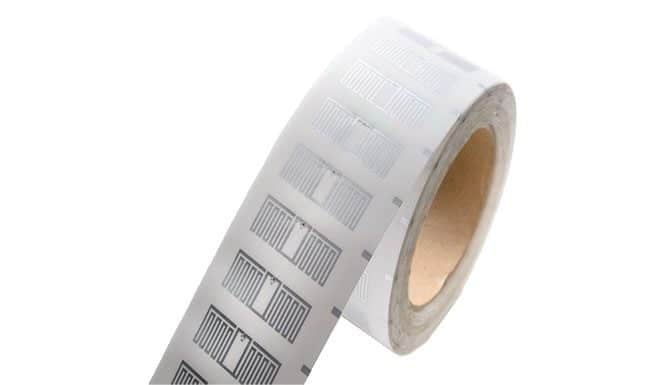RFID is growing at an impressive rate as engineers work to push the limits of what it can do. More and more application opportunities are being discovered and improved thanks to their hard work, bringing the Internet of Things to life.
In one of our recent projects our engineering team really pushed the limits and created a unique, practical and innovative RFID hybrid label. This label has the potential to not only allow for tracking of individual liquid samples from a distance, but optimizes short-distance tag reading during processing and provides at-a-glance recognition of sample processing status. These labels can also be utilized as hybrid barcode labels and integrate directly into your greater systems.
How did this come to be?
We worked to develop a solution for customers, such as those in the pharmaceutical industry that handle a large amount of liquid containers. Liquid samples can pose a challenge when it comes to RFID as liquids reduce the read range.
There are existing ways to reduce the impact of liquids on RFID when labeling sample tubes, such as foam backed labels, but these don’t work in every application. This project was, unfortunately, an example where finding a solution that reduced liquid interference was particularly difficult, so, we decided to try something new.
Ultimately, we decided to combine UHF-RFID with one of our existing products, the FLAP (Flexible Lamination After Printing) label. If you aren’t familiar with our FLAP labels they are pressure sensitive labels designed to improve the durability and tracking of barcode labels used on histology slides during automated staining processes. They feature a “flap” of laminate in the center of the label allowing the user to print on the un-laminated section beneath the flap, peel the release liner off of the laminator flap, and apply the laminate.
For this project we decided to, instead of utilizing the FLAP as a laminate for the facestock beneath, replace it with a UHF RFID tag. We kept the release liner in place on the back of the tag, and eliminated the facestock beneath so the tag can be applied directly to the container when the liner is removed.
How does this improve read range?
At this point you might be wondering how this type of label increases read range for improved inventory management. Well, similar to the foam backed label it creates space between the tag and the liquid sample. Where this differs from a foam backed label is that both the front and back of the label remain exposed allowing for further optimization of read range.
With increased read range, tags are optimized for use with smart shelves, door portals or even tag locator devices making inventory and workflow tracking a breeze.
How does it optimize short distance reading and provide at-a-glance status recognition?
This is where the release liner on the back of the tag becomes incredibly handy.
When the release liner is removed and the tag is adhered to the surface of the container the read range decreases, causing the RFID tag to perform more like a high frequency NFC tag.
For many facilities, the need for long distance reads ends once samples reach processing, meaning a tag that’s optimized for near field communication will be best suited for the job. This label provides the best of both worlds in that sense, you get the benefit of long read distances during storage/transport and the benefit of close read distances during processing.
On top of that, it just so happens that it’s clearly visible when the RFID tag portion of the label has been applied. This allows for at-a-glance status recognition, simplifying tracking.
It’s also a hybrid label?
Technically yes. The first half of the label can be printed on so it can serve the purpose of a hybrid label. Under most circumstances a barcode would be unnecessary since the flattened RFID tag serves a similar purpose, so we expect to see most customers utilize this space to provide human readable information. A barcode could serve the purpose of a back-up or store secondary information if necessary.
What makes this more than a label? Integration.
We may be best known for our labels, but that isn’t all we have to offer. We believe in providing our customers with complete labeling solutions, so they have everything they need to optimize their labeling process.
When it comes to RFID that means we won’t just give you the tags and a reader and expect you to figure out the rest, we’ll source all necessary equipment, compatible software and work with you through the entire process from conception through post installation service and upgrades.
Since not every facility has an RFID expert around, our experts will work with your team, processes and environment to ensure your RFID solution is not only functional, but built to run optimally under your specific conditions.
We’re really excited to see where this label goes. Whether it’s helping facilities that have yet to find a suitable RFID solution for their liquid samples, or improving traceability through an entire system, we feel like this application has a lot of potential.
If you have any questions about this project, please leave them in the comments below! If you have any questions about what Computype can specifically do for you, contact us directly!
